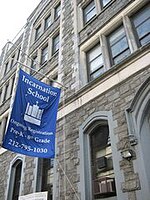Bridge Apartments
1964 establishments in New York (state)Apartment buildings in New York CityResidential buildings completed in 1964Use mdy dates from March 2022Washington Heights, Manhattan

The Bridge Apartments are four high-rise apartment buildings in the Washington Heights neighborhood of Manhattan, New York. Built between 1961 and 1964, they are notable for rising from concrete platforms directly above the Trans-Manhattan Expressway on its approach to the George Washington Bridge. Their proximity to the highway has led residents to complain of traffic noise and air pollution. The four buildings, each 32 stories tall, house about 4,000 people in total.
Excerpt from the Wikipedia article Bridge Apartments (License: CC BY-SA 3.0, Authors, Images).Bridge Apartments
Trans-Manhattan Expressway, New York Manhattan
Geographical coordinates (GPS) Address Nearby Places Show on map
Geographical coordinates (GPS)
| Latitude | Longitude |
|---|---|
| N 40.8476 ° | E -73.9349 ° |
Address
Trans-Manhattan Expressway
Trans-Manhattan Expressway
10033 New York, Manhattan
New York, United States
Open on Google Maps










